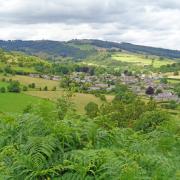Words by Helen Moat
CROMFORD TO BOLEHILL – WOODLAND & TRACK
From Cromford (limited parking in the square), walk a short distance along the Derby Road before taking a right up Intake Lane.
Soon you’ll leave the housing behind to follow a green lane through beech woodland. Pass under the High Peak Trail, curving round the edge of the woods before continuing southeast along the Midshires Way.
At the beginning of Birchwood Farm Caravan Park, follow the public footpath sign right to cross fields. At a crossroads of paths, turn right again to climb up through more meadows. Do stop to look back at the panoramic views of the Derwent Valley with Crich Tower on the skyline.
Soon the path will merge with a farm track at Wigwellnook Farm. Follow it down to Oakerthorpe Road, turning right to drop to Bolehill.
Join the High Peak Trail for a short distance, keeping an eye out for a path on the left that descends to Cromford, admiring more expansive views over the village, the mills, Richard Arkwright’s palatial home – Willersley Castle – and the Lower Derwent Valley.

At the end of your walk, take time to visit the wonderfully eccentric Scarthin Books and recuperate with a cuppa behind the Potteresque curved bookcase.
MATLOCK TO TANSLEY – COUNTRYSIDE VISTAS
Park up opposite Highfields Upper School and follow Lumsdale lane away from the Chesterfield Road junction.
Veer left to follow a second country lane to the top of Lumsdale, passing a delightful reclaimed mill pond.
Another mill pond sits serenely below the Pond Cottages at the top of Lumsdale gorge. Take time to follow the waterside path to the dammed wall and peer over the edge to see the first of a series of waterfalls cascading through a narrow gorge.
The ruined mills, squeezed into the narrow ravine, are now slowly returning to nature. Drop down to explore this other-worldly valley.
Catch a gable here, a paneless window frame there, a missing doorway or roof and a right angle of remaining wall.
Seek out the surviving flue, wheel pit and lynchpin, the curved wall of a paint vat and the convex stone where a millstone once ground.
The first watermill was built here in the 1600s. By the height of the Industrial Revolution there were at least seven mills active on this site.
Return to the Pond Cottages and turn right to follow the unmade lane towards Tansley. The lane rises before dropping down to the village, glorious views of the settlement and the surrounding countryside opening out in front of the rambler.

The rough track reaches Oaksedge Lane. Turn left at the bottom to cross the bridge and climb The Knoll through the village to The Gate, a popular contemporary village pub serving decent food.
Refreshed, retrace your steps to the top of the lane but this time head through the gap in the wall just past Oakedge Farm to wander through the forested hills and holes of Lumsdale Quarry, an ethereal place of exposed rocks and soaring conifers.
Emerging from the woodland, drop down to the little footbridge that crosses over to Highfields School and your starting point.
EDENSOR TO PILSLEY – ESTATE SPENDOUR
It would be difficult to find a more charming starting point for a green lane amble than that of Edensor.
Before stepping out, explore St Peter’s Church with its iconic steeple soaring heavenwards between the folds of Chatsworth’s parkland.
Inside, the Cavendish Chapel contains grand monuments commemorating Bess of Hardwick’s sons – William, the first Earl of Devonshire and Henry Cavendish.
Outside in the churchyard, significantly more modest gravestones are given up to more recent descendants of Bess, including the poignant grave of Kathleen Cavendish, married to William Cavendish and sister of John F Kennedy.
Tragically, she died in a small aircraft accident at the tender age of 28 having lost her husband in the War a short time after their marriage. Nearby, a commemorative stone marks Kennedy’s visit to his sister’s grave.

Returning to the triangular green, you can’t help but delight in the architectural features of Edensor. The relocated estate settlement, moved because it was impeding the sixth duke’s view, was designed by Chatsworth head gardener, Joseph Paxton and his assistant John Robertson, later augmented by eminent architect, George Henry Stokes.
The story goes the duke, confused by all the architectural choice presented to him by Robertson, simply chose one of each design, resulting in a charming mish-mash of Italianate, Norman, Gothic and Jacobean cottages and villas.
Having taken in the delights of the model village, adorned with decorative bargeboards, corbels, cupolas, pedimented windows, balustrades and castellated towers, continue up the long lane until it meets an unmade road.
At the top of the green lane, two right turns take you along Handley Lane, then the B6048 to a staggered junction at Pilsley.
Turn left to visit this second estate village with its pretty village school and country pub, the Devonshire Arms. Turn right for Chatsworth Farm Shop, filled with quality local produce and other tempting wares.
The courtyard restaurant offers fine views over the Chatsworth estate. To complete your circular walk, continue down the B6040 until it meets the B6012.
Turn right again, passing Chatsworth Golf Club and the handsome Grade II eighteenth-century Cavendish Hall, now a health and fitness club. Soon after, you’ll cross the cattlegrid to reach Edensor again.
EYAM TO STONEY MIDDLETON – PLAGUE POIGNANCY
From Stoney Middleton, head up The Nook (opposite the Moon Inn) with its honey-hewed stone buildings. Detour right to visit the unusual octagonal church of St Martin’s in this lovely corner of the village.
The original church (destroyed by fire) was commissioned by Joan Eyre of Padley in 1415 in thanksgiving for the safe return of her husband from the Battle of Agincourt.
Continuing up The Nook, you’ll come to a restored Roman-style bath house, built in 1815. Peep through the wrought-iron railings to get a glimpse of the interior with its partitioned baths for men and women, changing rooms and fireplaces.

The surrounding area has been a place of worship since Celtic times, the warm springs of the area considered to have healing properties. It’s also worth dropping into Stoney Middleton Cemetery a little further on to explore the Commonwealth War Graves of WWI and WWII.
Now the going gets a little tougher as the stony track climbs steeply into woodland. Catch your breath and take in the peace and stillness of the leafy surrounds.
The green lane emerges at the elbow of New Road. Cross over and continue uphill, veering left into more woodland. At the end of the track turn left again onto Riley Lane.
Take time to visit the Riley Graves enclosure on the Lefthand side and view the six graves and tomb of Mrs Hancock’s children and husband, all plague victims. Continue downhill along New Road and The Causeway.
Surrounding the village square, there are a number of good options for refreshments: the Miner’s Arms, Village Green Café and Eyam Tearooms.
Spend time exploring this unique village, where its residents followed the orders of Mompesson and Stanley, two men of the cloth, isolating themselves for the greater good. Given the fact around three-quarters of Eyam’s population died in the plague over the winters of 1665 and ‘66, it was an astonishing act of self-sacrifice.
Visit the Plague Cottages, the church and Eyam Museum to find out more before retracing your steps along the Causeway, this time taking a right down Lydgate. You’ll find another enclosure here – the Lydgate Graves – where yet more plague victims, George Darby and his daughter Mary, are buried.
Leave Lydgate behind to follow the grassy path along the ridge with stupendous views of the White Peak. Look out for the Boundary Stone, where the residents of Stoney Middleton didn’t dare pass during the Plague.
Instead, they left coins in the drilled holes of the stone, as well as food and medicine. Soon after the path drops down to The Fold. Follow Stoney Middleton’s lanes downhill until you arrive back at your starting point.




























